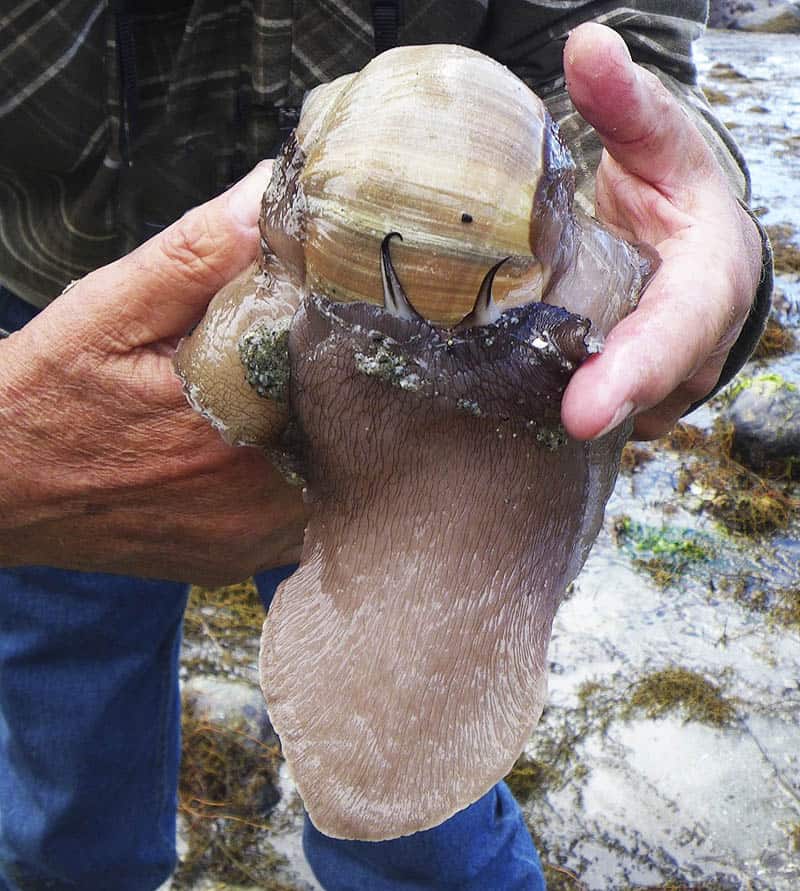(All photographs are the author’s unless indicated otherwise.)
We all have seen and marvelled: Lewis’ Moon Snail (Neverita lewisii), just as a shell and even more so in the flesh, is a very impressive marine snail indeed.
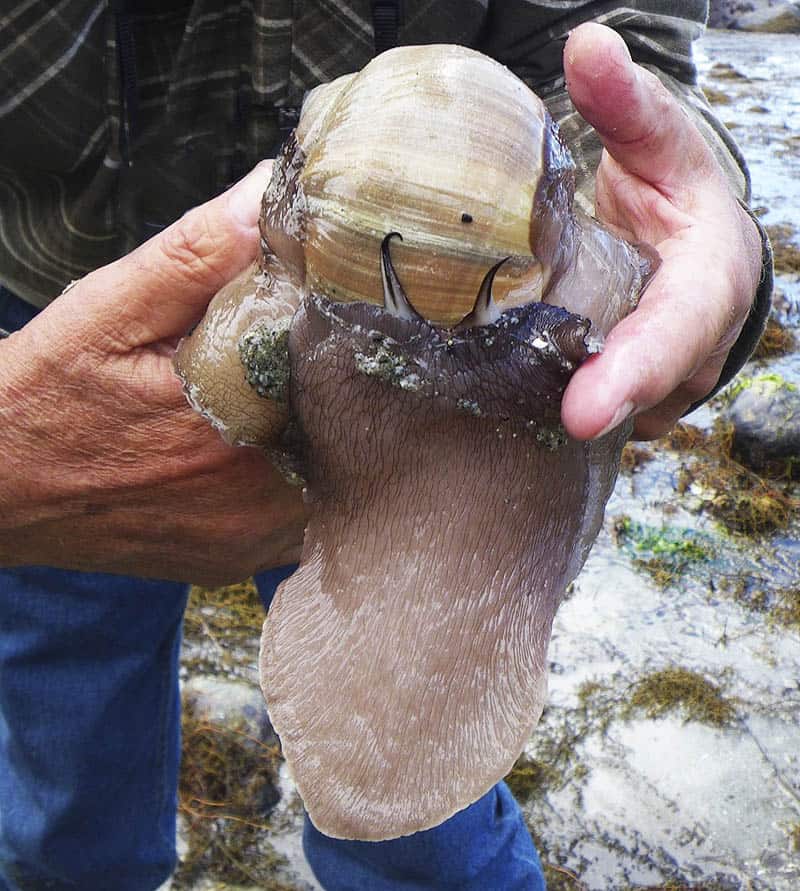
Difficult to imagine, but the large body of this snail can be withdrawn into the shell completely. It appears that a lot of water is expelled during this relatively slow process, which continues until the entire soft body (snails are molluscs, after all) is protected, and the operculum (a kind of trap-door, made from horny material and attached to the back of the snail’s foot) closes the shell opening completely.

Several hundred species of Moon Snails are recognized worldwide. The sea surrounding Cortes Island is home to 5 of them, including Lewis’, which happens to be the largest member of its family (Naticidae). For some reason, the taxonomy of Moon Snails is more confusing and frustrating than that of other groups of animals: it turns out that the common names are more reliable than the technical ones: Lewis’ Moon Snail, Drake’s Moon Snail, Arctic Moon Snail, Aleutian Moon Snail, Pallid Moon Snail.
To give an example of the mess Moon Snail taxonomy is in, here is a recent update on naming Lewis’ from Wikipedia:
Neverita lewisii (previously known as Polinices lewisii, Lunatia lewisii, Euspira lewisii), common name Lewis’s moon snail, is a species of large operculated sea snail. It is a predatory marine gastropod in the family Naticidae, the moon snails. Traditionally, this species was assigned to either the genus Lunatia, the genus Policies or the genus Euspira. Recently, it was assigned to the genus Neverita based on molecular data.
Taxonomy is supposed to represent the true evolutionary relationships between different organisms (as in the genealogies or family trees many humans try to establish for their own ancestry). Obviously, with the enormous advances made in genetic research and DNA analysis, the geneticists have a lot to say about how closely or distantly related two living beings are. This leads not only to revisions of long-standing patterns, but it also puts into question the validity of the entire Linnaean system, where an organism can be assigned to a species, which belongs to a genus, which fits into a family, which is part of an order, then a class and, finally, a phylum (which belongs to one of the “kingdoms”, of which, usually, five are recognized).
None of these challenges the fact that 5 distinct Moon Snails have been observed in the waters around Cortes Island. The author is in possession of 4 and would heartily appreciate finding (or receiving as a gift) number 5: the Pallid Moon Snail! Having the complete collection would make a fine contribution to the Cortes Museum.
Lewis’ Moon Snail, as mentioned above, is the largest member of its family. Being quite common, especially in sandy or muddy intertidal habitats, most of us will be familiar, not only with the beautiful globose shells but with the fact that the animal spends most of its time buried and ploughing through the substrate, in search of clams or even other snails. All Moon Snails are predatory, and they subdue their prey by enveloping it in their large foot and then proceeding to “drill” a hole through the shell. With the aid of acidic enzymes and a very competent radula (a kind of tooth-covered tongue), Moon Snails create very neat, countersunk boreholes.
Once the hole is completed, the contents of the shell are consumed via a proboscis.
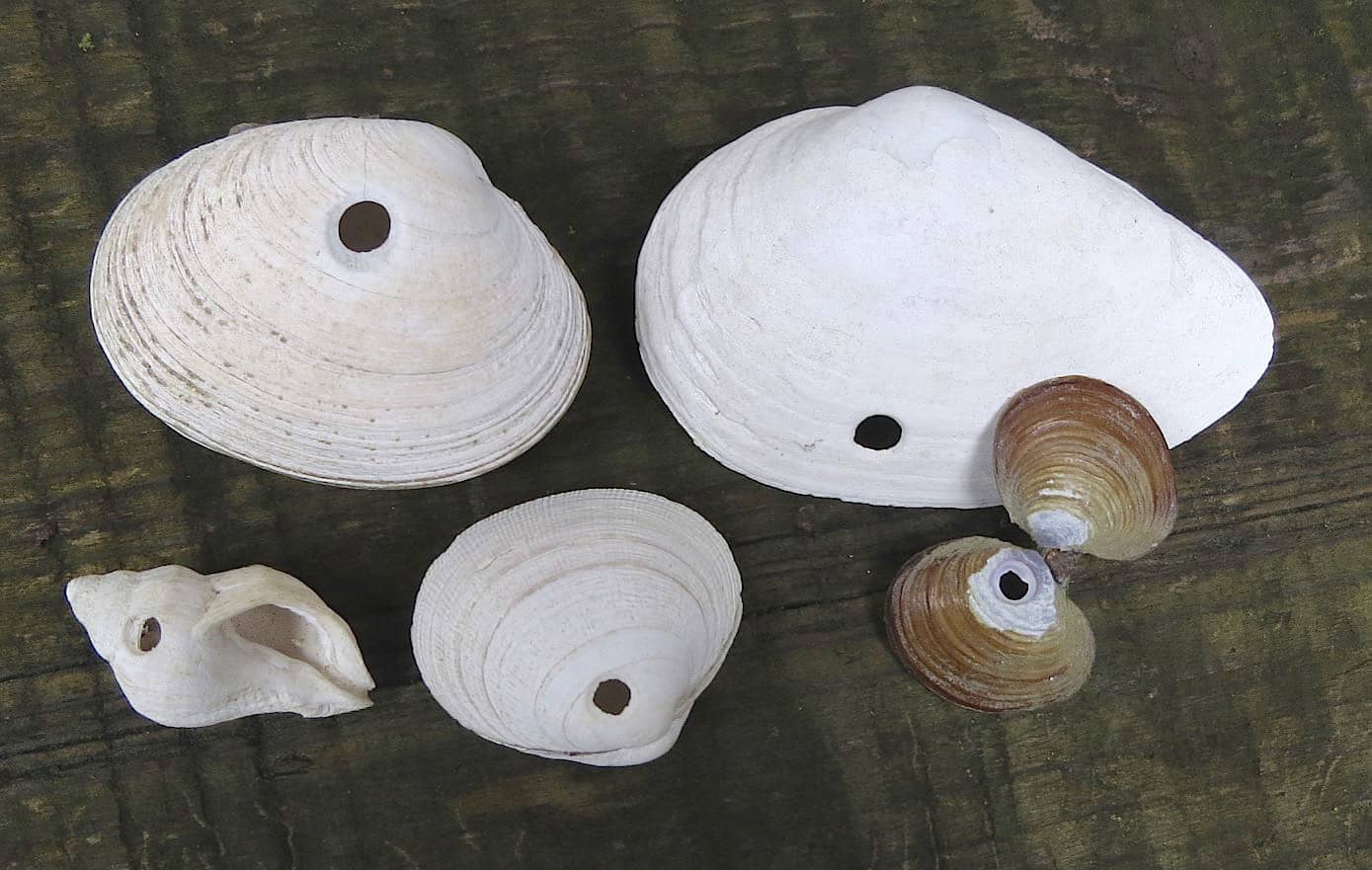
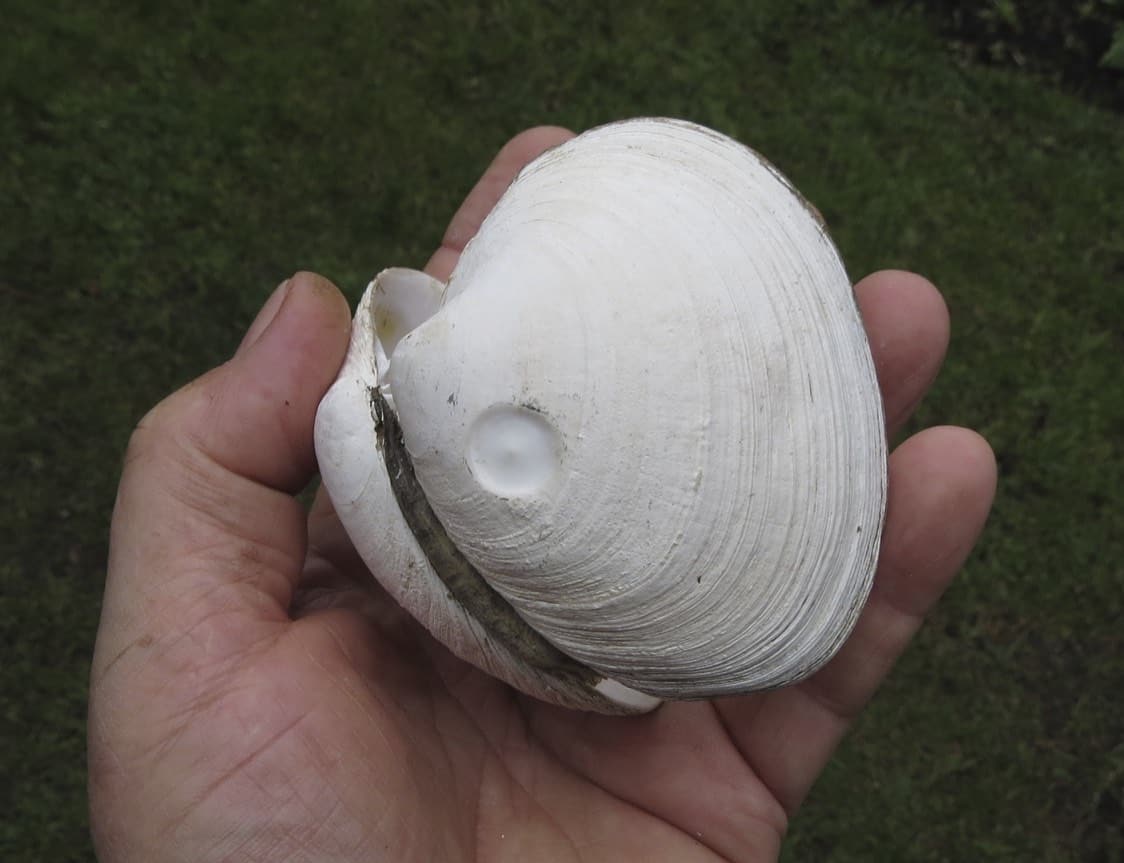
As well as drilled clamshells, the beach-walker frequently encounters the conspicuous sand- or egg-collars of Lewis’ Moon Snail.
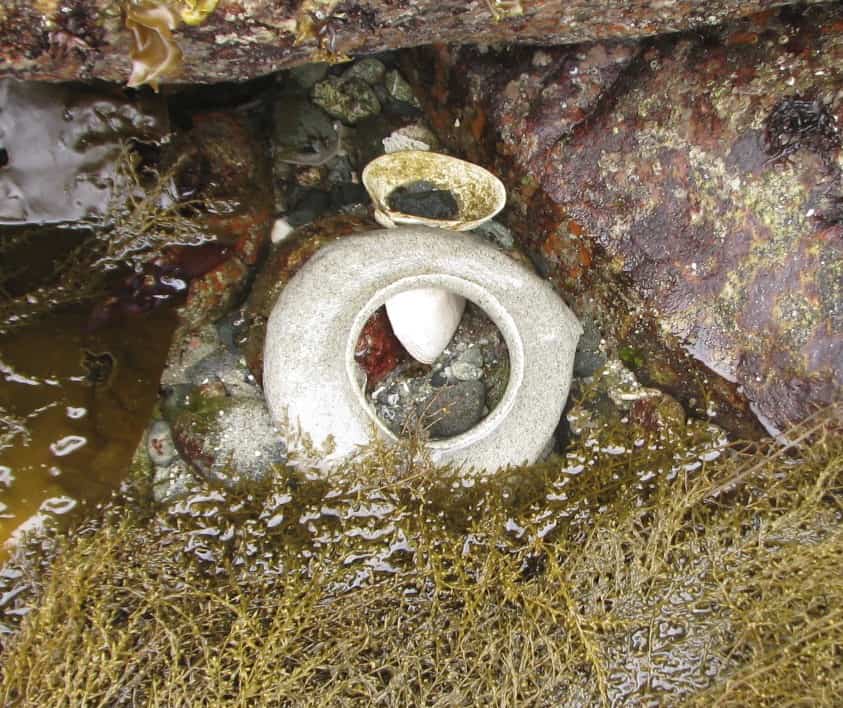
As the female snail lays her eggs, she mixes them with sand and mucous and forms the pliable mass around her shell. The several thousand eggs per collar (each around one-sixth of a millimetre wide) spend only about one week within the egg collar, which explains why they are seldom observed, even though many collars are littering the sandy intertidal areas. Once the hatched larvae (called Veligers) leave the egg collar, they spend four to five weeks in the plankton, before settling to the ocean bottom. Within a few days, they have taken up the typical Moon Snail lifestyle of predation by drilling tiny countersunk holes through the shells of ostracodes (clam-like crustaceans) and tiny clams. The small juveniles of Lewis’ Moon Snail probably live subtidally, for their shells are almost never found.
Smaller and of lighter build than Lewis’, Drake’s Moon Snail (Glossaulax draconic, synonyms: Lunatic draconis, Polinices draconis.) occurs sub-tidally, and it is unlikely that an intact shell will be found on our beaches. But just that is what Brigitte Grosse did, several years ago, not far from her home at the Loon Ranch:
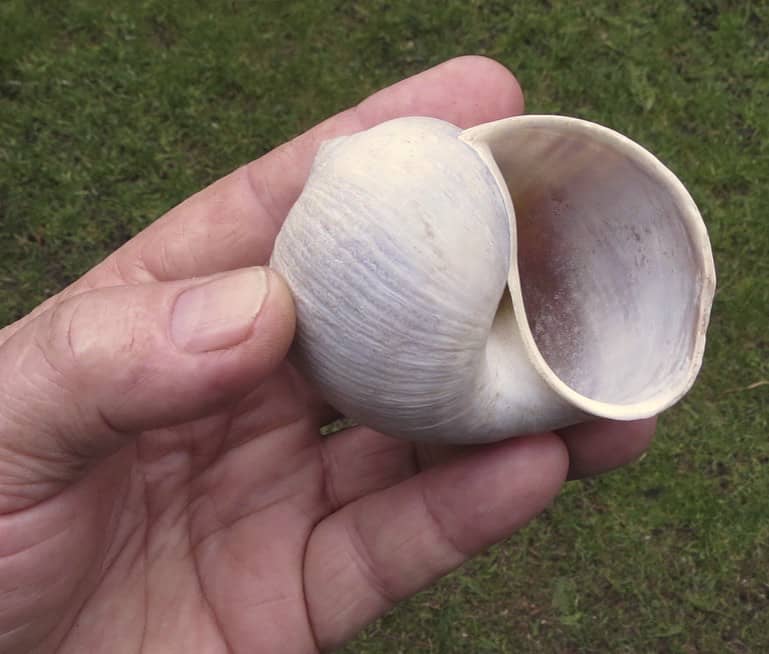
The chances of finding an Arctic Moon Snail are better, since the species inhabits the sub- to intertidal beaches around Cortes Island, though it is not very common:
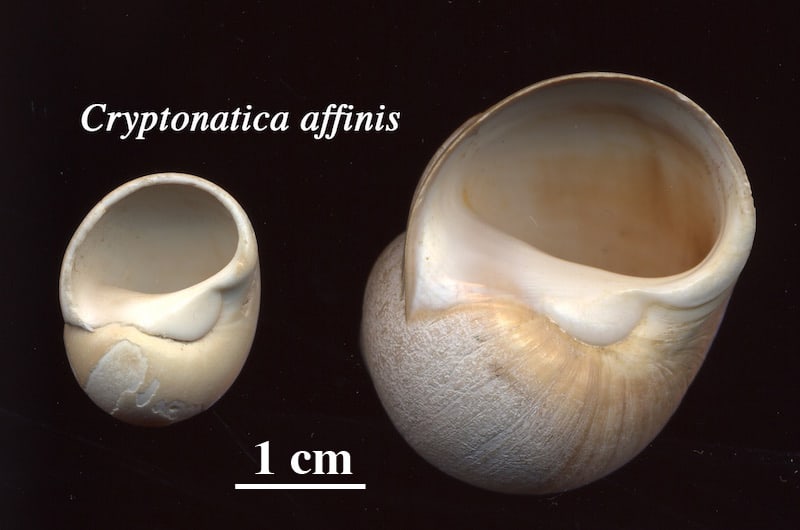
Note: “clausa” referred to the closed umbilicus characteristic of this genus.
Making matters more complicated is the fact that the intertidal Aleutian Moon Snail shell is almost identical to the Arctic one – with the exception of an indistinct whitish band surrounding the shell’s (closed) umbilicus:
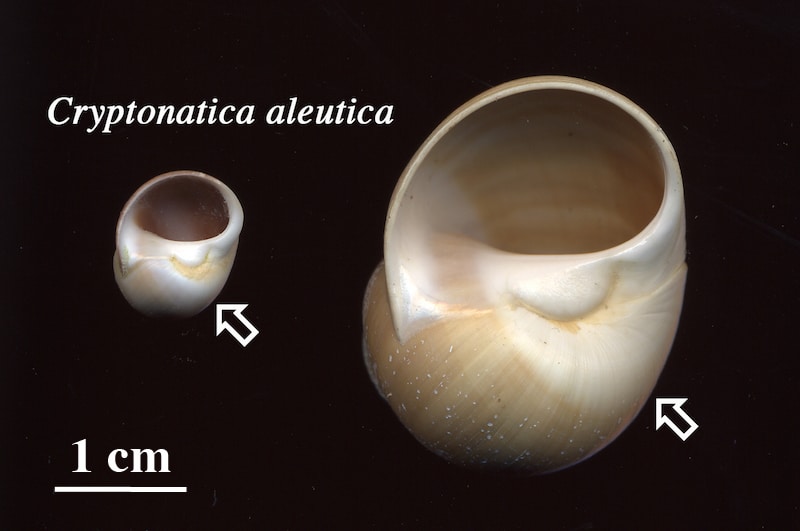
Live specimens are more easily distinguished by the colouration of the snail’s flesh, which is clear white for the Arctic and speckled brown for the Aleutian Moon Snail.

The latter two species offer another glimpse at the taxonomic confusion that occasionally befalls even the experts (names shall be withheld, so as not to embarrass the guilty): in the first edition of a recent field guide (since corrected and reissued), the image of an Aleutian Moon Snail was identified as an Arctic Moon Snail and, hard to believe, given the scientific name of the Pallid Moon Snail Euspira pallida!
The Pallid Moon Snail is the fifth member of the local assembly of Moon Snail species, to be encountered in Cortes Island waters – and it is the one missing from the author’s collection:

Note the higher spire of the shell, giving it a less globose appearance, compared with the other Moon Snails.
And, just as a special treat, here is a more or less complete list of synonyms for this particular species – so you can appreciate what a taxonomist has to wade through (OCD actually helps):
Euspira canonica Dall, 1919
Euspira politiana Dall, 1919
Lunatia choshiensis Tiba, 1985
Lunatia pallida Broderip & G. B. Sowerby I, 1829
Natica borealis Gray, 1839
Natica caurina Gould, 1847
Natica groenlandica Möller, 1842
Natica pallida Broderip & G. B. Sowerby I, 1829 (original combination)
Natica pusilla Gould, 1841
Neverita politiana Dall, 1919
Polinices (Lunatia) pallida Broderip & G. B. Sowerby I, 1829
Polinices groenlandica [sic] (incorrect gender ending)
Polinices groenlandicus Möller, 1842
Polinices pallidus Broderip & Sowerby, 1829
The good news is: the snails don’t care!
And, not being fanatically devoted to systematic accuracy, the sheer beauty of seashells is rewarding enough to keep one’s eyes open and one’s back stooped when walking on the beach…
It is perhaps a more fortunate destiny to have a taste for collecting shells than to be born a millionaire.
— Robert Louis Stevenson, 1850 – 1894
Taxonomy anywhere else in science is apt to strike a certain type of impatient student as a gratuitous orgy of pedantry. Doubtless, compulsions to intellectual tidiness express themselves prematurely at times, and excessively at others, but a good descriptive taxonomy, as Darwin found in developing his theory, and as Newton found in the work of Kepler, is the mother of laws and theories.
— Raymond Cattell, 1905 – 1998
Taxonomy (the science of classification) is often undervalued as a glorified form of filing—with each species in its folder, like a stamp in its prescribed place in an album; but taxonomy is a fundamental and dynamic science, dedicated to exploring the causes of relationships and similarities among organisms. Classifications are theories about the basis of the natural order, not dull catalogues compiled only to avoid chaos.
— Stephen Jay Gould, 1941 – 2002

